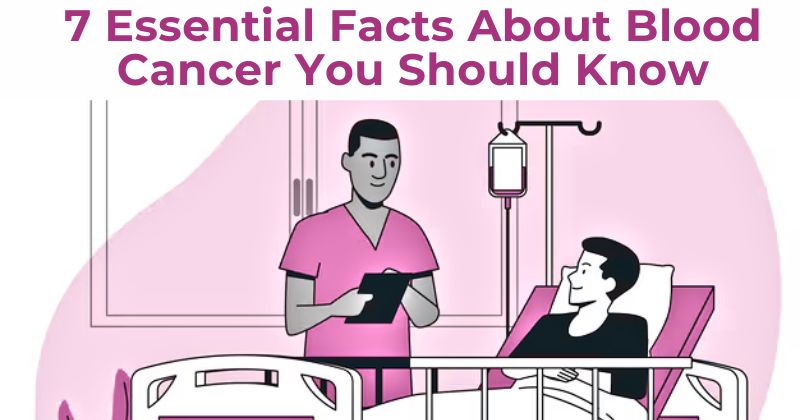Blood cancer is one of the most complex and life-altering diseases affecting millions worldwide. While the diagnosis can be overwhelming, advancements in medical science and treatment strategies have greatly improved the prognosis for many patients. In this blog, we’ll walk you through 7 essential facts about blood cancer, including causes, symptoms, and the best blood cancer treatment options available today. Understanding the basics about blood cancer can help demystify the disease, promote early detection, and empower individuals with knowledge about treatment and care.
Table of Contents
1. Blood Cancer Is Not Just One Disease
The term blood cancer encompasses several different types of malignancies that affect the blood, bone marrow, or lymphatic system. The three main types are:
- Leukemia – affects white blood cells and can be acute or chronic.
- Lymphoma – begins in the lymphatic system and includes Hodgkin and non-Hodgkin lymphoma.
- Myeloma – also known as multiple myeloma, affects plasma cells in the bone marrow.
Each type behaves differently, and the treatment approach varies significantly depending on the subtype and stage of the disease. For instance, myeloma blood cancer treatment requires a distinct protocol compared to leukemia.
2. Symptoms Can Be Vague and Overlooked
Early symptoms of blood cancer can be subtle and often mistaken for less serious illnesses. Common signs include:
- Fatigue and weakness
- Frequent infections
- Unexplained weight loss
- Easy bruising or bleeding
- Bone or joint pain (especially in myeloma)
Swollen lymph nodes
Because these symptoms are nonspecific, they can go unnoticed until the disease has advanced. That’s why routine medical checkups and blood tests are crucial, especially for those at higher risk.
3. Risk Factors Vary but Genetics Play a Role
Blood cancer can affect anyone, but certain factors increase the risk:
- Age (most types are more common in older adults)
- Family history of blood cancer
- Exposure to radiation or certain chemicals (e.g., benzene)
- Weakened immune system
- Certain infections, like Epstein-Barr virus (linked to lymphoma)
While not all cases are preventable, being aware of risk factors can help prompt earlier screening and diagnosis.
4. Early Diagnosis Significantly Improves Outcomes
As with most cancers, early detection can lead to more effective treatment. Doctors typically use a combination of the following to diagnose blood cancer:
- Complete blood counts (CBC)
- Bone marrow biopsy
- Imaging tests like CT or PET scans
- Genetic and molecular testing
These tests help determine the type and stage of cancer, which is vital in choosing the best blood cancer treatment options available for each individual.
5. Treatment Depends on the Type and Stage
Blood cancer treatments have evolved drastically over the past decade, offering more personalized and targeted therapies. Standard treatments include:
- Chemotherapy: The mainstay for many blood cancers, especially leukemia.
- Radiation therapy: Often used for lymphoma.
- Stem cell transplantation: Particularly useful in severe or relapsed cases.
- Targeted therapy: Drugs that focus on specific genetic changes in cancer cells.
- Immunotherapy: Boosts the body’s immune response to fight cancer.
When it comes to myeloma blood cancer treatment, therapies often involve combinations of chemotherapy, targeted drugs (like proteasome inhibitors and immunomodulatory drugs), and sometimes stem cell transplants. Treatment strategies are often tailored depending on the patient’s age, overall health, and the aggressiveness of the cancer.
6. Survivorship and Quality of Life Are Prioritized
Cancer treatment doesn’t end with remission. Survivors of blood cancer often require long-term follow-up care to monitor for relapse, manage side effects, and address emotional health. Supportive therapies—including physical therapy, counseling, and nutritional support—play a crucial role in improving quality of life.
Today’s comprehensive cancer centers offer holistic care plans that include survivorship programs designed to support both physical and mental well-being during and after treatment.
7. Cutting-Edge Research Is Driving Hope
The future of blood cancer treatment looks promising thanks to continuous research. Clinical trials are exploring innovative approaches, including:
- CAR T-cell therapy
- Gene editing (like CRISPR)
- Personalized medicine based on genetic profiling
- Combination therapies that enhance existing treatment efficacy
These advances are reshaping the standard of care, bringing hope to patients even with aggressive or recurrent forms of the disease. Staying informed about ongoing research and clinical trials can open doors to new treatment avenues.
Final Thoughts
Being diagnosed with blood cancer is life-changing, but it’s no longer the grim scenario it once was. With a deeper understanding of the disease and access to the best blood cancer treatment options available, patients today can look forward to better outcomes and improved quality of life. In the case of conditions like myeloma, seeking expert care and exploring all myeloma blood cancer treatment avenues is essential. Whether you’re navigating a diagnosis yourself or supporting a loved one, knowledge is power. Staying informed about symptoms, treatments, and emerging research ensures you’re equipped to make the best possible decisions about your care. In the case of conditions like myeloma, seeking expert care and exploring all myeloma blood cancer treatment avenues is essential.
For More (Click Here)



